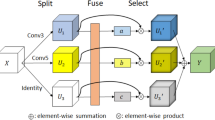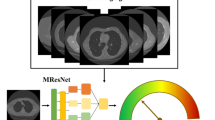Abstract
Lung cancer has the highest mortality rate of all cancers, and early detection can improve survival rates. In the recent years, low-dose CT has been widely used to detect lung cancer. However, the diagnosis is limited by the subjective experience of doctors. Therefore, the main purpose of this study is to use convolutional neural network to realize the benign and malignant classification of pulmonary nodules in CT images. We collected 1004 cases of pulmonary nodules from LIDC-IDRI dataset, among which 554 cases were benign and 450 cases were malignant. According to the doctors’ annotates on the center coordinates of the nodules, two 3D CT image patches of pulmonary nodules with different scales were extracted. In this study, our work focuses on two aspects. Firstly, we constructed a multi-stream multi-task network (MSMT), which combined multi-scale feature with multi-attribute classification for the first time, and applied it to the classification of benign and malignant pulmonary nodules. Secondly, we proposed a new loss function to balance the relationship between different attributes. The final experimental results showed that our model was effective compared with the same type of study. The area under ROC curve, accuracy, sensitivity, and specificity were 0.979, 93.92%, 92.60%, and 96.25%, respectively.








Similar content being viewed by others
References
Bray F, Ferlay J, Soerjomataram I, Siegel RL, Torre LA, Jemal A: Global cancer statistics 2018: GLOBOCAN estimates of incidence and mortality worldwide for 36 cancers in 185 countries. CA: A Cancer Journal for Clinicians 68(6): 394-424, 2018
Siegel RL, Miller KD, Jemal A: Cancer statistics, 2018. CA: A Cancer Journal for Clinicians 68(1): 7-30, 2018
Oudkerk M, Devaraj A, Vliegenthart R et al.: European position statement on lung cancer screening. LANCET ONCOL 18(12): E754-E766, 2017
Gould MK, Maclean CC, Kuschner WG, Rydzak CE, Owens DK: Accuracy of positron emission tomography for diagnosis of pulmonary nodules and mass lesions: a meta-analysis. JAMA 285(7): 914-924, 2001
Liu Y, Balagurunathan Y, Atwater T: Radiological Image Traits Predictive of Cancer Status in Pulmonary Nodules. CLIN CANCER RES 23(6): 1442-1449, 2017
Zhang G, Yang Z, Gong L: An Appraisal of Nodule Diagnosis for Lung Cancer in CT Images.J MED SYST 43(7): 181, 2019
Han F, Wang H, Zhang G et al.: Texture Feature Analysis for Computer-Aided Diagnosis on Pulmonary Nodules. J DIGIT IMAGING 28(1): 99-115, 2015
Ye X, Lin X, Dehmeshki J, Slabaugh G, Beddoe G: Shape-based computer-aided detection of lung nodules in thoracic CT images. IEEE TRANSACTIONS ON BIOMEDICAL ENGINEERING 56(7): 1810-1820, 2009
Dhara AK, Mukhopadhyay S, Dutta A, Garg M, Khandelwal N: A Combination of Shape and Texture Features for Classification of Pulmonary Nodules in Lung CT Images. J DIGIT IMAGING 29(4): 466-475, 2016
Wang H, Zhao T, Li LC et al.: A hybrid CNN feature model for pulmonary nodule malignancy risk differentiation. J Xray Sci Technol 26(2): 171-187, 2018
Farag AA, Ali A, Elshazly S, Farag AA: Feature fusion for lung nodule classification. INTERNATIONAL JOURNAL OF COMPUTER ASSISTED RADIOLOGY AND SURGERY 12(10): 1809-1818, 2017
Nibali A, He Z, Wollersheim D: Pulmonary nodule classification with deep residual networks. INT J COMPUT ASS RAD 12(10): 1799-1808, 2017
Polat H, Mehr HD: Classification of Pulmonary CT Images by Using Hybrid 3D-Deep Convolutional Neural Network Architecture.Applied Sciences 9(5): 940, 2019
Huang XJ, Shan JJ, Vaidya V: Lung nodule detection in CT using 3D convolutional neural networks. In: ISBI, 2017, pp 379-383
Dou Q, Chen H, Yu L, Qin J, Heng PA: Multilevel Contextual 3-D CNNs for False Positive Reduction in Pulmonary Nodule Detection. IEEE transactions on bio-medical engineering 64(7): 1558-1567, 2017
Liu K, Kang G: Multiview convolutional neural networks for lung nodule classification. INT J IMAG SYST TECH 27(1):12-22, 2017
Ciompi F, Chung K, van Riel SJ: Towards automatic pulmonary nodule management in lung cancer screening with deep learning. SCI REP-UK 7: 46479, 2017
Li X, Kao Y, Shen W, Li X, Xie G: Lung Nodule Malignancy Prediction Using Multi-task Convolutional Neural Network. In: Medical Imaging 2017: Computer-Aided Diagnosis, vol 10134, 2017, UNSP 1013424. International Society for Optics and Photonics
Kang B, Zhu WP, Liang D: Robust multi-feature visual tracking via multi-task kernel-based sparse learning. IET IMAGE PROCESS 11(12): 1172-1178, 2017
Armato SG, McLennan G, Bidaut L, McNitt-Gray MF, Meyer CR, Reeves AP, Zhao B, Aberle DR, Henschke CI, Hoffman EA et al.: The Lung Image Database Consortium (LIDC) and Image Database Resource Initiative (IDRI): A Completed Reference Database of Lung Nodules on CT Scans. MED PHYS 38(2): 915-931, 2011
Kazerooni EA, Austin JHM, Black WC, Dyer DS, Hazelton TR, Leung AN, McNitt-Gray MF, Munden RF, Pipavath S: ACR-STR Practice Parameter for the Performance and Reporting of Lung Cancer Screening Thoracic Computed Tomography (CT). JOURNAL OF THORACIC IMAGING JOURNAL OF THORACIC IMAGING 29(5): 310-316, 2014
Aberle DR, Adams AM, Berg CD, Black WC, Clapp JD, Fagerstrom RM, Gareen IF, Gatsonis C, Marcus PM, Sicks JD: Reduced lung-cancer mortality with low-dose computed tomographic screening. NEW ENGL J MED 365(5): 395-409, 2011
He K, Zhang X, Ren S, Sun J. Deep residual learning for image recognition. In: Proceedings of the IEEE Conference on Computer Vision and Pattern Recognition, 2016, pp 770–778
He K, Zhang X, Ren S, Sun J: Identity Mappings in Deep Residual Networks. In: European Conference on Computer Vision. Springer, 2016, pp 630–645
Kline DM, Berardi VL: Revisiting squared-error and cross-entropy functions for training neural network classifiers. Neural Computing and Applications 14(4): 310-318, 2015
Facebook Inc. Pytorch. Available at https://pytorch.org. Accessed 16 August 2018
Zhang Y, Yang Z, Lu H, Zhou X, Phillips P, Liu Q, Wang S: Facial Emotion Recognition Based on Biorthogonal Wavelet Entropy, Fuzzy Support Vector Machine, and Stratified Cross Validation. IEEE ACCESS 4:8375-8385, 2016
Kamnitsas K, Ledig C, Newcombe VFJ, Simpson JP, Kane AD, Menon DK, Rueckert D, Glocker B: Efficient multi-scale 3D CNN with fully connected CRF for accurate brain lesion segmentation. MED IMAGE ANAL 36: 61-78, 2017
Lyu J, Ling SH: Using multi-level convolutional neural network for classification of lung nodules on CT images. In: 2018 40th Annual International Conference of the IEEE Engineering in Medicine and Biology Society. IEEE, 2018, pp 686-689
Xie Y, Zhang J, Xia Y, Fulham M, Zhang Y: Fusing texture, shape and deep model-learned information at decision level for automated classification of lung nodules on chest CT. INFORM FUSION 42:102-110, 2018
Xie Y, Xia Y, Zhang J: Knowledge-based Collaborative Deep Learning for Benign-Malignant Lung Nodule Classification on Chest CT. IEEE T MED IMAGING 38(4): 991-1004, 2019
Causey JL, Zhang J, Ma S, Jiang B, Qualls JA, Politte DG, Prior F, Zhang S, Huang X: Highly accurate model for prediction of lung nodule malignancy with CT scans. SCI REP-UK 8:9286, 2018
Funding
The paper supported by the General Object of National Natural Science Foundation (61772358) Research on the key technology of BDS precision positioning in complex landform; Project supported by International Cooperation Project of Shanxi Province (Grant No.201603D421014) Three-Dimensional Reconstruction Research of Quantitative Multiple Sclerosis Demyelination; International Cooperation Project of Shanxi Province (Grant No. 201603D421012): Research on the key technology of GNSS area strengthen information extraction based on crowd sensing.
Author information
Authors and Affiliations
Corresponding author
Ethics declarations
Conflict of Interest
The authors declare that they have no conflict of interest.
Additional information
Publisher’s Note
Springer Nature remains neutral with regard to jurisdictional claims in published maps and institutional affiliations.
Rights and permissions
About this article
Cite this article
Zhao, J., Zhang, C., Li, D. et al. Combining multi-scale feature fusion with multi-attribute grading, a CNN model for benign and malignant classification of pulmonary nodules. J Digit Imaging 33, 869–878 (2020). https://doi.org/10.1007/s10278-020-00333-1
Published:
Issue Date:
DOI: https://doi.org/10.1007/s10278-020-00333-1




